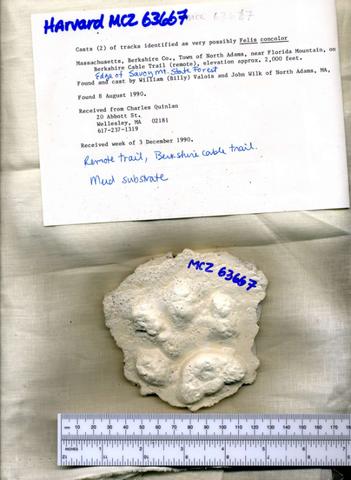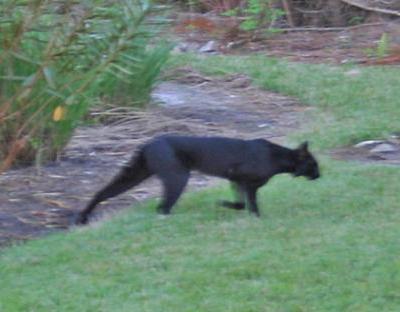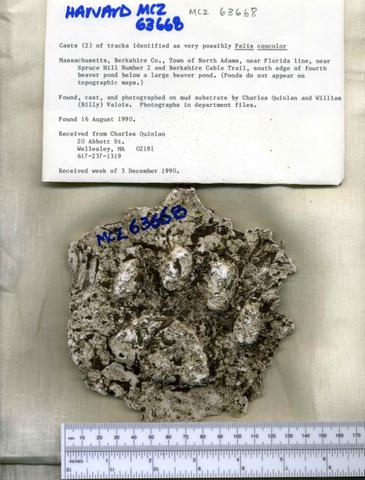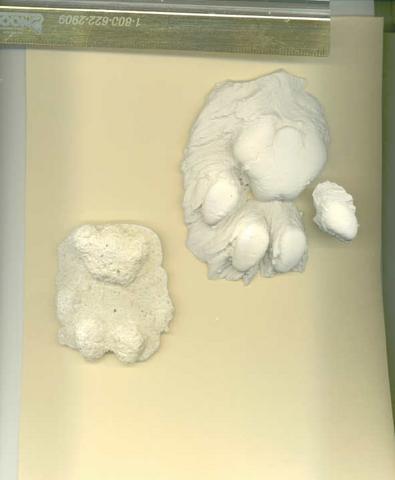
January 29, 2007

On display at Harvard’s Museum of Comparative Zoology: The verified casts (one shown above, the other below) of credible eastern cougar tracks found in Massachusetts in 1990.
Naturalist Helen McGinnis’ of the Eastern Cougar Foundation, during January 2007, has raised some questions about the above during their “Project Hoax.”

A Mystery Melanistic Felid captured on film in Florida turned out to be a black bobcat.
Helen McGinnis, in the late 1970s, gathered evidence and privately published her findings in papers widely distributed to cryptozoologically-minded associates saying she thought upwards of 40% of the mystery cats in that state were melanistic.
But a few years ago, McGinnis joined with the skeptical Eastern Cougar Foundation (ECF), and they began to control the eastern cougar listserv.
Over the last few weekends, McGinnis has focussed her debunkings against the pro-cougar evidence at the Harvard’s Museum of Comparative Zoology.
McGinnis details her “insights” on January 22nd, about cougar casts that were made in the summer of 1990 in the Berkshires of western Massachusetts:
Judy Chupasko, manager of the mammal collection in the Museum of Comparative Zoology (MCZ) at Harvard University, displayed them at the 2004 Eastern Cougar Conference in Morgantown, WV. At the time I was not impressed with them, but in late April of last year, I was looking at the skulls in the MCZ collection and came upon the casts, which are catalogued and stored in the Puma collection. This time I was excited. The casts are accompanied by a lengthy transcript of a conversation with one of the two men involved in the alleged discovery and casting of the tracks.
The photos of the two casts are now in the [ECF’s] Hoax file.
In the transcript the person involved says that he’s had several encounters with cougars in western Massachusetts. He’s heard them scream, he has seen them, and he was even attacked by a mother with a kitten. The mother came leaping toward him. This person is a respected naturalist who has done faunal and botanical surveys of natural areas in New England. I talked with him on the phone, and he corroborated what is in the transcript.
However, the tracks are clearly a hoax. The heel pads are not correctly shaped and appear to have been made with some object with a semi-circular edge pressed into the ground. The toes could easily have been made by pressing fingers into the substrate.
Jim Cardoza of the Massachusetts Department of Fish and Game was involved in the initial examination of the casts. He believes that they are fakes.
What makes this hoax significant is that the casts are catalogued in the collection of the MCZ, one of the oldest and most respected research natural history museum in the United States. – Helen McGinnis

She writes on January 27th:
Actually, there are two names in the transcript associated with the casts. I discussed these casts with Jim Cardoza perhaps a year ago. He suggested that some local person created the fake tracks. If so, perhaps one or both the named people were victims, not hoaxers. I would hate to accuse anyone of hoaxing on a public forum without exceedingly good evidence. Here we have a hoax but not enough evidence to point a finger at the guilty person.
However, I am suspicious of all the sightings etc that the naturalist claims to have had. If any of you reading this live in New England and are familiar with the Berkshires–is it common to have so many sightings there? – Helen McGinnis
McGinnis is ignoring the long history of sightings in that area and her debunking may be groundless. McGinnis and the ECF’s members have been routinely calling most tracks found in the East hoaxes.

Then there’s the case of the Alleghany footcasts (directly above and at bottom) that the ECF claim are fakes too. John Lutz’s take on what has been happening with those tracks found recently in Pennsylvania merely reflects another chapter in the two organizations’ dispute. Lutz’s email, which also turns personal, was sent out to his associates on January 21st, and follows:
We were advised this week by longtime law enforcement friend who belongs to both EPRN & ECF that members of Eastern Cougar Foundation has begun a smear campaign against the Eastern Puma Research Network.
They dispute the track evidence of an adult puma & cub that we found on Alleghany Front last February is a hoax, claiming the tracks were from some sort of material that one of the smear campaigners created him or herself.
We call it “sour grapes” from ECF, since we were called on the incident & responded to the scene. The area has had repeated or cluster sightings of mountain lions & a few cubs since the 1930s, for which we have records.
It was our understanding when we originally went on the incident that another phone number (listed to ECF was also called but the person only got a recording).
If there had been a live person at that ECF number, and a live person would have responded immediately like we (EPRN) did, they could have possibly found the same evidence. The only difference would be, we (EPRN) wouldn’t have made up a smear campaign against ECF.
I wonder if ECF would have made up a smear campaign against themselves if they had found the same evidence we did??
I was deeply disappointed when Todd Lester didn’t come out & dispute untruths that were spread by ECF members when EPRN’s Chief Pennsylvania Researcher Roger Cowburn died on February 18th, 2006, but that was sort of another smear campaign against EPRN.

The obituary and life record of Roger Cowburn (above) was allegedly besmeared by some in the ECF, apparently only because he was an active EPRN fieldworker who believed he had found evidence of eastern cougars.
Todd Lester & I had been friends from the mid-1980s, when he began his interest with cougars & learned much of his data from the late Frank & Ellen Weed at their animal compound in southern Florida. Frank & Ellen had raised cougars for 40 years & even was helping Todd in obtaining a license to keep a cougar in West Virginia.
Todd originally was a member of our Eastern Puma Research Network & only left us to form the Eastern Cougar Research Center in North Springs, WV. in 1995.
Prior to then in 1990, he owned the Black Powder Kennels which supplied animals for restocking programs, especially raccoons, which WV DNR opposed.
I have always maintained the highest degree of integrity in all my professions including track enforcement & investigations, cryptozoology & strange phenomena studies and since the mid-1960s mountain lions & black panthers.
Its become a very sad day in America when even professional scientists stoop so low as being sour grape campaigners….– John A. Lutz
Director and Founder
Eastern Puma Research Network

Credit for video capture (no pun intended) from KSTP-TV.
The sightings of a mystery cat in a Willmar, Minnesota neighborhood resulted in the capture of a mountain lion (above) on the first of February 2006. The recent sightings of a cougar in Manitoba were confirmed with the following photograph.
Click on this image of a Manitoba cougar for a larger version.

About Loren Coleman
Loren Coleman is one of the world’s leading cryptozoologists, some say “the” leading living cryptozoologist. Certainly, he is acknowledged as the current living American researcher and writer who has most popularized cryptozoology in the late 20th and early 21st centuries.
Starting his fieldwork and investigations in 1960, after traveling and trekking extensively in pursuit of cryptozoological mysteries, Coleman began writing to share his experiences in 1969. An honorary member of Ivan T. Sanderson’s Society for the Investigation of the Unexplained in the 1970s, Coleman has been bestowed with similar honorary memberships of the North Idaho College Cryptozoology Club in 1983, and in subsequent years, that of the British Columbia Scientific Cryptozoology Club, CryptoSafari International, and other international organizations. He was also a Life Member and Benefactor of the International Society of Cryptozoology (now-defunct).
Loren Coleman’s daily blog, as a member of the Cryptomundo Team, served as an ongoing avenue of communication for the ever-growing body of cryptozoo news from 2005 through 2013. He returned as an infrequent contributor beginning Halloween week of 2015.
Coleman is the founder in 2003, and current director of the International Cryptozoology Museum in Portland, Maine.
Filed under Alien Big Cats, Artifacts, Breaking News, Conspiracies, Cryptomundo Exclusive, Cryptotourism, CryptoZoo News, Cryptozoologists, Cryptozoology, Mystery Cats, Obituaries, Pop Culture, Public Forum